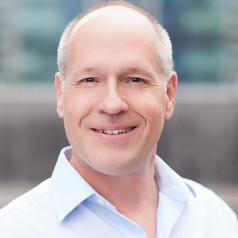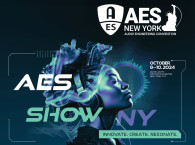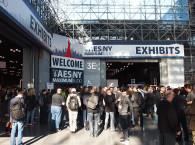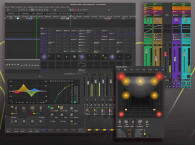After three days of the AES Show New York convention, the annual flagship event of the Audio Engineering Society, there was an evening haze settling along the city skyline, with starlight behind the Javits Center and the Hudson River. Yet the last night in Manhattan turned into a clear one. Registrations were reportedly up this year for the AES Show, with the opening ceremony on Day 1 at full capacity, occupying all 300 theater seats, and upwards of 6,000 visitors to the convention during the three days.
The first news from day one was announced by the current AES president. The next US AES Convention will be in Long Beach, CA, in October 2025. “We heard you ask,” said Dr. Leslie Gaston-Bird, “and we will see you in California next year!”


Leaving the Javits Center this year, left me to ponder if the AES was heading in a fresh direction - not just West, but more focused on the engineering and research content that drew many into the Society to begin with. During the three days and nights of the Convention, there was plenty to reconnect with, some that served the recording and mixing world, some crossing through that world and into wearables, wireless speakers, audio networks, new digital audio technologies, better test, measurement, subjective evaluation, and into the world of automotive audio.
The AES Show 2024 NY and 157th Audio Engineering Society Convention allowed several leading manufacturers to showcase cutting-edge solutions and demonstrate the latest products. A wide array of workshops, panels, demos, and training sessions appealed to both researchers and practitioners.
“The buzz on the floor at this year’s show was exhilarating and overwhelmingly positive, confirming AES’s global strengths in showcasing the latest audio technology innovations as well as nurturing a community passionate about all things audio,” said AES President Leslie Gaston-Bird. “Through hundreds of technological demonstrations, presentations, and networking events, the convention demonstrated again how the entire audio industry is dedicated to enthusiastically sharing knowledge and expertise to uplift everyone in our field.”

Beyond the announcement that next year’s Convention will take place in Long Beach (October 23-25, 2025), other upcoming AES events were announced for next year. An exciting calendar ahead, with the eagerly awaited AES Headphone conference as one of the highlights.
April 3-5, 2025, San Diego, CA - Conference on Diversity, Equity and Inclusion
May 24-26, 2025, Warsaw, Poland - AES Europe Conference
August 15-17, 2025 - Latin American Convention
August 27-29, 2025, Alto, Finland - International Conference on Headphone Technology
September 8-10, 2025, London, England - International Conference of Artificial Intelligence and Machine Learning for Audio
October 23-25, 2025, Long Beach, CA - AES US Conference

During the opening ceremonies, the AES Gold Metal was awarded to Dr. Gilbert Soulodre. When Gil was asked, he said he received it "for being old." Officially, The AES Gold Medal Award (formerly The John H. Potts Memorial Award) is given “in recognition of outstanding achievements, sustained over a period of years, in the field of Audio Engineering.” Dr. Soulodre also presented the Richard C. Heyser Memorial Lecture during the 2022 Convention in NYC. Old, and talented, I would add.
Dr. Gilbert Soulodre has many years of experience in the field of audio as a research scientist, a product developer, and a mixing engineer. He has written numerous scientific papers in the areas of concert hall acoustics, psychoacoustics and spatial perception, subjective testing, loudness metering, digital signal processing, and multichannel audio. As the founder and CEO of Camden Labs, he has invented a variety of signal processing algorithms and has authored many patents. His product development work stretches across a wide range of areas including automotive audio, mobile phones and tablets, consumer electronics, immersive cinema surround sound, virtual reality, microphone array processing, speech processing, the music recording industry, audio restoration, audio compression, hearing aids, business telecom, and military voice communications.
Gil Soulodre was the head of the Audio Perception Lab at the Communications Research Center in Canada where he led a team of researchers studying numerous topics in audio and acoustics. During that time, he developed the subjective testing methods that are used in the ITU-R BS.1116 and BS.1534 (MUSHRA) standards. He was formerly a professor in the Sound Recording program at McGill University and in the Department of Psychology at Carleton University. He was a visiting scientist in the Acoustics Department of the National Research Council in Canada. Recently, Gil was a visiting lecturer at the Sound Engineering department of UNTREF university in Buenos Aires.
Gil Soulodre is a Fellow of the AES and has received recognition and awards from the Acoustical Society of America, the American Institute of Physics, the IEEE, and the Canadian Government. In 2006, he received the AES Publications Award for his work on spatial perception in immersive sound environments. Gil developed a method for accurately measuring and predicting the perceived loudness of audio signals. This technology was adopted as an international standard (EBU R-128) and is now used extensively around the world. In 2012, Gil received a Technology and Engineering Emmy Award from the National Academy of Television Arts and Sciences for this work.


Music producer and engineer, Ebonie Smith gave an inspiring keynote address titled “W.O.K.E. Why? Opportunity. Kinship. Equity.” in which she discussed the new challenges of economic change in the audio and recording industry, the part Artificial Intelligence is playing, and the need for improving both working conditions and pay of audio engineers. She stressed being ever vigilant, aware, and agile in the modern age during the new challenges of economic change in the audio and recording industry, as well as about AI. Sharing the wealth of new audio recordings through crowdfunding. Pushing the improvement of working conditions of audio engineers and the improvement of their pay. Over work and burn out in the recording industry has been the norm. Using modern tools to our advantage instead of continuing to harm ourselves. Follow her @eboniesmithmusic on Instagram for more.
Later in the afternoon, Sean Olive, a Senior Fellow for Harman International, presented his continuing work on listening tests and target settings for in-ear headphones. “A comparison of in-ear headphone target curves for the Brüel & Kjær Head & Torso Simulator Type 5128”. Controlled listening tests were conducted on five different in-ear (IE) headphone target curves measured on the latest ITU-T Type 4.3 ear simulator (e.g., Bruel & Kjaer Head & Torso Simulator Type 5128). A total of 32 listeners rated each target on a 100-point scale based on preference for three different music programs with two observations each. When averaged across all listeners, two target curves were found to be equally preferred over the other choices. Agglomerative hierarchical clustering analysis further revealed two classes of listeners based on dissimilarities in their preferred target curves. Class One (72% of listeners) preferred the top two rated targets. Class Two (28% of listeners) preferred targets with 2dB less bass and 2dB more treble than the target curves preferred by Class One. Among the demographic factors examined, age was the best predictor of membership in each class. His paper is available for download by AES Members in the e-library.
Merging Technologies was made part of Sennheiser’s Neumann division in June 2022. This year, during the AES in New York, Merging Technologies took over Lounge Studios on West 39th Street in Manhattan. They were premiering the latest version of Pyramix, which continues to be the digital audio workstation (DAW) of choice for a significant amount of high-quality audio productions, offering unmatched audio fidelity with track counts and I/O capabilities up to 384 low-latency I/O at 44.1/48kHz, and 64 I/O in DSD/DXD. Strong past partnerships with software developers, such as FLUX Audio (now part of Harman Samsung as of December 2023) for immersive audio plug-ins, have elevated the newest Pyramix 15.
During dinner that night, hosted by Neumann, I was able to swap stories across the table with Jim Anderson, a legendary multiple Grammy award-winning recording engineer. (He was also a Mets fan that night, catching the score over the shoulder of my seatmate, Bob Friedrich, the other Grammy award-winning recording engineer - and producer - at the table.) Jim recommended Bob for one of his first recording gigs: "Jim said I had good ears, and kept my mouth shut." Jim confirmed both. Jim and I dug into his years in the 1970s and 1980s at NPR. We later caught up with each other again the next day in the Genelec demo room, which was a similar set up as at the Automotive Audio Conference in Sweden, and which was standing room only for George Massenburg's immersive audio demonstrations.

In product development, Jeff Anderson who is working with SPARK Microsystems, presented on “Objective Audio Quality Evaluation of UWB (Ultra Wideband) Wireless Transmission.” Jeff presented an audio transmission data comparison of UWB and straight S/PDIF wire link at data rates up to 24-bits and 96Ks/s showing that UWB is nearly indistinguishable from a wire. I spent some time afterward with Jeff and SPARK’s co-founder, Frederic Nabki. The use of 24-bit 96kHz audio was new for SPARK and UWB, which is a leap beyond legacy versions of Bluetooth in a short-range wireless communication device. SPARK recently announced the inclusion of their technology in Focal’s DIVA Utopia loudspeakers.
Focal took the transceiver reference design provided by SPARK and created their own design package. The transceiver package is a 4mm footprint at the moment, which works well in loudspeakers and headphones. For earbuds, the reference design from SPARK would be repackaged to be even smaller. At the AES Show they demonstrated UWB used to connect two loudspeakers, but they also demoed 5.1 multichannel audio playback using a UWB hub, which manages the audio clocks and syncing between each of the loudspeakers.
In gaming headphones, the short-range distance of UWB is ideal for gaming at a PC, but they also marry their audio management with Bluetooth LE for when the gamer wants to go to the kitchen but stay connected. The audio is no-longer low latency, and no longer wideband, but it provides a “safety blanket,” said Frederic, when the distance is temporarily needed, and the latency and bandwidth aren’t critical in the moment. According to Frederic, SPARK is currently working on a very well-funded project with a studio monitor and microphone supplier for a studio and recording monitoring system. SPARK Microsystems will have a suite at CES 2025 to demonstrate their UWB headset and speaker implementations.

My next highlight from this AES conference must be about John La Grou's Imersiv Multi-Path converters. In a December 2023 article, Jan Didden wrote about the launch of the D1 DAC from Imersiv, a new brand launched at last year’s AES Convention. I caught up with John La Grou, who is behind the creation of Imersiv, and which many recognize as the founder of Millennia Media. The unique approach in the Imersiv D1 has been to replace the approach to achieving improved dynamic range, which uses two separate DACs on two separate chips to maintain the high resolution with low latency, with a multi-path approach which splits the signal into high- and low-resolution components in one DSP and processing the two separate signals and recombining them to achieve 162dB of dynamic range.
John’s AES Tech Brief from last year, his US Patents (9.590.648, 9.871.530, 10.256.782), and Jan Didden’s coverage for audioXpress should provide all the technical details about John’s successful concept. The essential problem for single path DACs is that when the signal is below 40dB, total harmonic distortion starts to climb. John described his multi-path approach with an analogy. “Think about how an HDR (High Dynamic Range) camera works,” he said. “It takes three pictures of different resolution and contrast and marries them together to get a picture with better dynamic range than a ‘single’ path camera.”

In the D-1, a SHARC DSP is used to analyze the signal for high- and low-resolution components. They are digitally crossfaded to keep track of all the bits to avoid dither before output into High DAC and Low DAC paths toward an analog output. The low-resolution signal is boosted in gain by +35dB in the SHARC to be able to work more easily with the low-resolution data. There is a Gate on the High DAC output controlled by SHARC that shuts off the High DAC output when the signal is all Low DAC output (when the input was all -40dB and below). If the input is above -40dB, a summation of high and low is output. Before output and summation, the Low DAC attenuates the signal by 35dB to its original level, and with that the noise floor goes with it.
Imersiv is expecting to be shipping the D1 in early 2025 and will be at NAMM in January 2025. John La Grou has a target of being at CES in 2026 with a product he expects to be in contention for an Innovation award. In the long term, he is looking at ways to make the multi-path approach ubiquitous, becoming the next paradigm of audio design in automotive, mobile, pro, and home.


At the end of this AES NY convention, I spent some time with the new AES Executive Director, Emily Burch, who is very interested in bringing more engineering and research-based product development content to the next US convention in Long Beach. She would like to see the possibility of again providing a guided path for the attendees of the technical program to follow that provides collected presentations and workshops focused on audio product development in Automotive and Mobility, Loudspeakers and Microphones, and DSP and Simulation. aX
This article was originally published in The Audio Voice newsletter, (#490), October 24, 2024.






